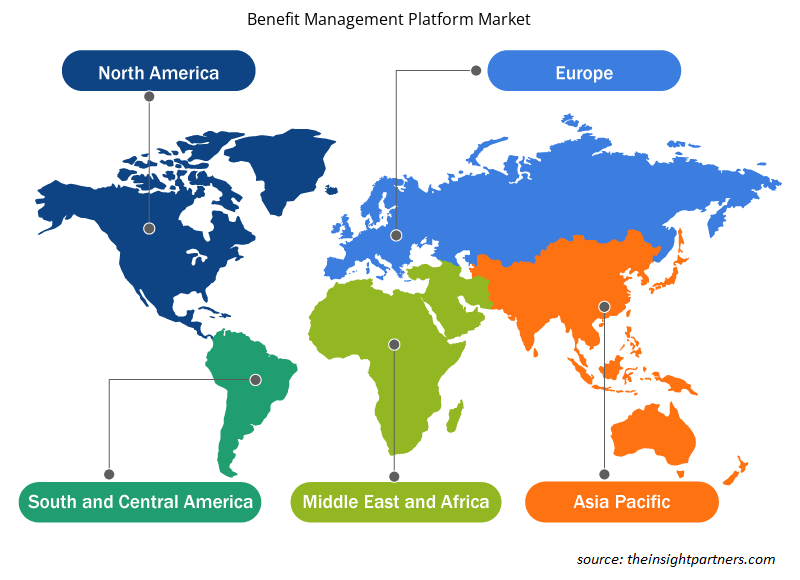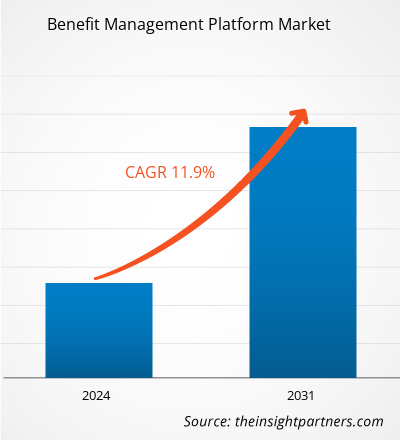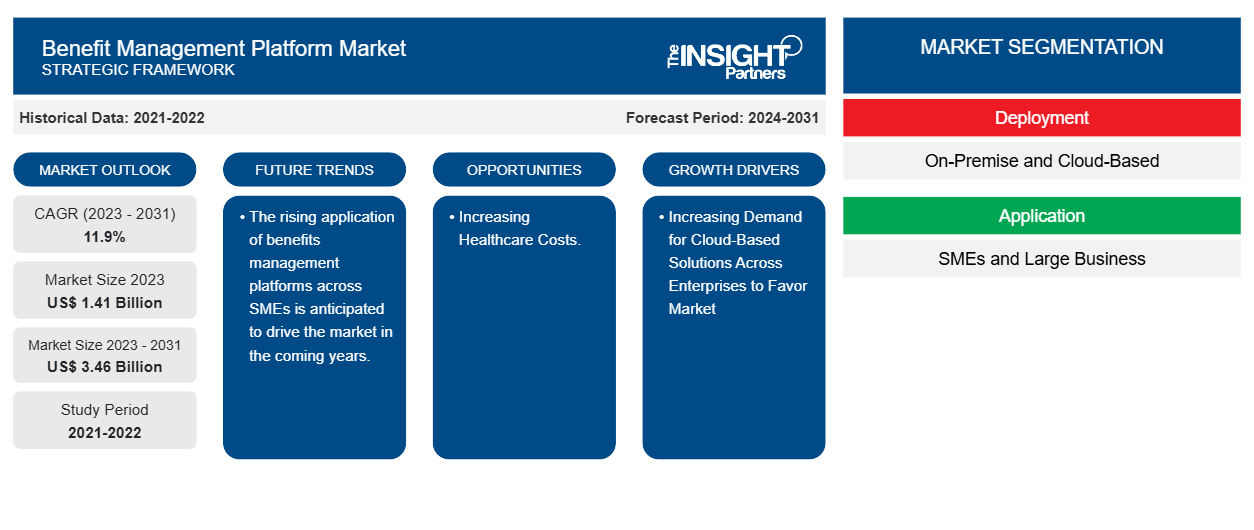Si prevede che la dimensione del mercato delle piattaforme di gestione dei benefit raggiungerà i 3,46 miliardi di dollari entro il 2031, rispetto agli 1,41 miliardi di dollari del 2023. Si prevede che il mercato registrerà un CAGR dell'11,9% nel periodo 2023-2031. La crescita crescente delle soluzioni basate su cloud in varie aziende e i maggiori costi sanitari rimarranno probabilmente tendenze e driver chiave nel mercato.
Analisi di mercato della piattaforma di gestione dei benefici
Si prevede che la domanda per il mercato delle piattaforme di gestione dei benefit crescerà con la crescita crescente delle soluzioni basate su cloud nelle aziende e una maggiore domanda di praticità supportata dalle tecnologie; i costi sanitari più elevati stanno alimentando la crescita del mercato. Inoltre, si prevede che diverse iniziative governative e applicazioni crescenti nelle PMI alimenteranno la crescita del mercato nel periodo di previsione.
Panoramica del mercato delle piattaforme di gestione dei benefici
Le piattaforme di gestione dei benefit sono progettate per riconoscere il comportamento di un dipendente e aiutare il datore di lavoro a offrire vari benefit per operazioni aziendali efficienti. Tali soluzioni sono utili per migliorare il morale del personale e premiare il loro impiego nell'organizzazione. Queste piattaforme sono frequentemente utilizzate in aziende praticamente di tutte le dimensioni grazie alle loro innovazioni tecnologiche.
Personalizza questo report in base alle tue esigenze
Riceverai la personalizzazione gratuita di qualsiasi report, comprese parti di questo report, o analisi a livello nazionale, pacchetto dati Excel, oltre a usufruire di grandi offerte e sconti per start-up e università
-
Scopri le principali tendenze di mercato in questo rapporto.Questo campione GRATUITO includerà analisi di dati che spaziano dalle tendenze di mercato alle stime e alle previsioni.
Driver di mercato e opportunità della piattaforma di gestione dei benefici
La crescente domanda di soluzioni basate su cloud nelle aziende favorisce il mercato
La crescente domanda di soluzioni basate su cloud tra le aziende sta alimentando la crescita del mercato delle piattaforme di gestione dei benefit. Le soluzioni basate su cloud possono facilmente scalare per adattarsi alla crescita delle aziende, che si tratti di aggiungere nuovi dipendenti o di espandersi a livello globale. Le piattaforme di gestione dei benefit possono anche ridurre il costo dei modelli di abbonamento IT. Inoltre, migliorano l'accesso remoto agli aggiornamenti in tempo reale. Inoltre, ci sono diverse piattaforme di gestione dei benefit sul mercato. Ad esempio, Zenefits è una piattaforma HR basata su cloud che offre un'ampia gamma di funzionalità, tra cui amministrazione dei benefit, elaborazione delle buste paga, monitoraggio del tempo e gestione della conformità. Inoltre, fornisce un'interfaccia intuitiva per i dipendenti per gestire i propri benefit e si integra con varie applicazioni di terze parti. Pertanto, la crescente domanda di soluzioni basate su cloud tra le aziende sta guidando la crescita del mercato.
Aumento dei costi sanitari.
Negli ultimi anni, i crescenti costi dell'assistenza sanitaria sono diventati una preoccupazione urgente sia per i datori di lavoro che per i dipendenti. Con le spese mediche in costante aumento, la sostenibilità dei benefit per i dipendenti è sotto esame. Poiché l'assistenza sanitaria diventa sempre più costosa, le aziende affrontano la sfida di mantenere solidi pacchetti di benefit che attraggano e trattengano i talenti, gestendo al contempo i costi in modo efficace. Ciò aumenta la domanda di una piattaforma di gestione dei benefit. Con l'aumento dei costi dell'assistenza sanitaria, i datori di lavoro e gli individui cercano modi per gestire e ridurre le spese. Pertanto, l'aumento dei costi dell'assistenza sanitaria offre immense opportunità per il mercato delle piattaforme di gestione dei benefit.
Analisi della segmentazione del rapporto di mercato della piattaforma di gestione dei benefici
I segmenti chiave che hanno contribuito alla derivazione dell'analisi di mercato della piattaforma di gestione dei vantaggi sono lo sviluppo e l'applicazione.
- In base allo sviluppo, il mercato delle piattaforme di gestione dei benefit è diviso in on-premise e basato su cloud. Si prevede che il segmento basato su cloud deterrà una quota significativa nel periodo di previsione.
- In base all'applicazione, il mercato delle piattaforme di benefit management è suddiviso in PMI e grandi aziende. Si prevede che il segmento PMI deterrà una quota significativa nel periodo di previsione.
Analisi della quota di mercato della piattaforma di gestione dei vantaggi per area geografica
L'ambito geografico del rapporto di mercato sulle piattaforme di gestione dei benefit è suddiviso principalmente in cinque regioni: Nord America, Asia Pacifico, Europa, Medio Oriente e Africa, Sud e Centro America.
Il Nord America ha dominato il mercato. La crescita del mercato in Nord America è attribuita alla crescente adozione di soluzioni basate su cloud e alla crescente domanda di un'amministrazione efficiente dei benefit per i dipendenti. Inoltre, la crescente domanda di soluzioni automatizzate per analizzare e gestire i benefit per i dipendenti. Inoltre, i progressi tecnologici nella regione e la costante attenzione alla ricerca e allo sviluppo stanno contribuendo alla crescita del mercato. Nella regione sono presenti numerosi fornitori di piattaforme di gestione dei benefit. Tutti questi fattori stanno guidando la crescita del mercato delle piattaforme di gestione dei benefit che sta guadagnando terreno in Nord America.
Approfondimenti regionali sul mercato della piattaforma di gestione dei benefici
Le tendenze regionali e i fattori che influenzano il Benefit Management Platform Market durante il periodo di previsione sono stati ampiamente spiegati dagli analisti di Insight Partners. Questa sezione discute anche i segmenti e la geografia del Benefit Management Platform Market in Nord America, Europa, Asia Pacifico, Medio Oriente e Africa e Sud e Centro America.

- Ottieni i dati specifici regionali per il mercato della piattaforma di gestione dei benefici
Ambito del rapporto di mercato sulla piattaforma di gestione dei benefici
| Attributo del report | Dettagli |
|---|---|
| Dimensioni del mercato nel 2023 | 1,41 miliardi di dollari USA |
| Dimensioni del mercato entro il 2031 | 3,46 miliardi di dollari USA |
| CAGR globale (2023-2031) | 11,9% |
| Dati storici | 2021-2022 |
| Periodo di previsione | 2024-2031 |
| Segmenti coperti |
Per distribuzione
|
| Regioni e Paesi coperti |
America del Nord
|
| Leader di mercato e profili aziendali chiave |
|
Piattaforma di gestione dei benefici Densità dei giocatori del mercato: comprendere il suo impatto sulle dinamiche aziendali
Il mercato delle piattaforme di Benefit Management sta crescendo rapidamente, spinto dalla crescente domanda degli utenti finali dovuta a fattori quali l'evoluzione delle preferenze dei consumatori, i progressi tecnologici e una maggiore consapevolezza dei benefici del prodotto. Con l'aumento della domanda, le aziende stanno ampliando le loro offerte, innovando per soddisfare le esigenze dei consumatori e capitalizzando sulle tendenze emergenti, il che alimenta ulteriormente la crescita del mercato.
La densità degli operatori di mercato si riferisce alla distribuzione di aziende o società che operano in un particolare mercato o settore. Indica quanti concorrenti (operatori di mercato) sono presenti in un dato spazio di mercato in relazione alle sue dimensioni o al valore di mercato totale.
Le principali aziende che operano nel mercato delle piattaforme di gestione dei benefici sono:
- Benefitfocus.com Inc
- Società
- Empireo
- Navigatore dei dipendenti
- Sollievo
- ADP, Inc.
Disclaimer : le aziende elencate sopra non sono classificate secondo un ordine particolare.

- Ottieni la panoramica dei principali attori del mercato delle piattaforme di gestione dei benefici
Notizie di mercato e sviluppi recenti sulla piattaforma di gestione dei benefici
Il mercato delle piattaforme di gestione dei benefit viene valutato raccogliendo dati qualitativi e quantitativi dopo la ricerca primaria e secondaria, che include importanti pubblicazioni aziendali , dati associativi e database. Di seguito sono elencati alcuni degli sviluppi nel mercato delle piattaforme di gestione dei benefit:
- Capgemini ha annunciato di aver firmato un nuovo accordo con Kallio Software per sviluppare un sistema di gestione dei benefit unificato per supportare quasi un milione di beneficiari di sussidi di disoccupazione in Finlandia. Questa nuova piattaforma è progettata per rendere la gestione dei processi di richiesta dei benefit più rapida e più incentrata sul cliente per una migliore esperienza del cliente. (Fonte: Capgemini, sito Web aziendale, maggio 2024)
- BambooHR ha lanciato Benefits Administration, una soluzione pensata per semplificare il processo di iscrizione ai benefit. Benefits Administration integra l'iscrizione ai benefit dei dipendenti nella piattaforma BambooHR, offrendo un'esperienza più rapida e comoda per tutti gli utenti.
(Fonte: BambooHR, sito web aziendale, giugno 2023)
Copertura e risultati del rapporto di mercato sulla piattaforma di gestione dei benefici
Il rapporto "Dimensioni e previsioni del mercato delle piattaforme di gestione dei benefici (2021-2031)" fornisce un'analisi dettagliata del mercato che copre le seguenti aree:
- Dimensioni e previsioni del mercato delle piattaforme di gestione dei benefit a livello globale, regionale e nazionale per tutti i principali segmenti di mercato interessati dall'ambito.
- Tendenze del mercato delle piattaforme di gestione dei benefici e dinamiche di mercato quali fattori trainanti, limitazioni e opportunità chiave.
- Analisi dettagliata delle cinque forze PEST/Porter e SWOT
- Analisi di mercato delle piattaforme di gestione dei benefit che copre le principali tendenze del mercato, il quadro globale e regionale, i principali attori, le normative e i recenti sviluppi del mercato.
- Analisi del panorama industriale e della concorrenza che copre la concentrazione del mercato, l'analisi delle mappe di calore, i principali attori e gli sviluppi recenti per il mercato delle piattaforme di gestione dei benefit.
- Profili aziendali dettagliati.
- Analisi storica (2 anni), anno base, previsione (7 anni) con CAGR
- Analisi PEST e SWOT
- Valore/volume delle dimensioni del mercato - Globale, Regionale, Nazionale
- Industria e panorama competitivo
- Set di dati Excel
Report recenti
Rapporti correlati
Testimonianze
Motivo dell'acquisto
- Processo decisionale informato
- Comprensione delle dinamiche di mercato
- Analisi competitiva
- Analisi dei clienti
- Previsioni di mercato
- Mitigazione del rischio
- Pianificazione strategica
- Giustificazione degli investimenti
- Identificazione dei mercati emergenti
- Miglioramento delle strategie di marketing
- Aumento dell'efficienza operativa
- Allineamento alle tendenze normative























 Ottieni un campione gratuito per - Mercato delle piattaforme di gestione dei benefici
Ottieni un campione gratuito per - Mercato delle piattaforme di gestione dei benefici